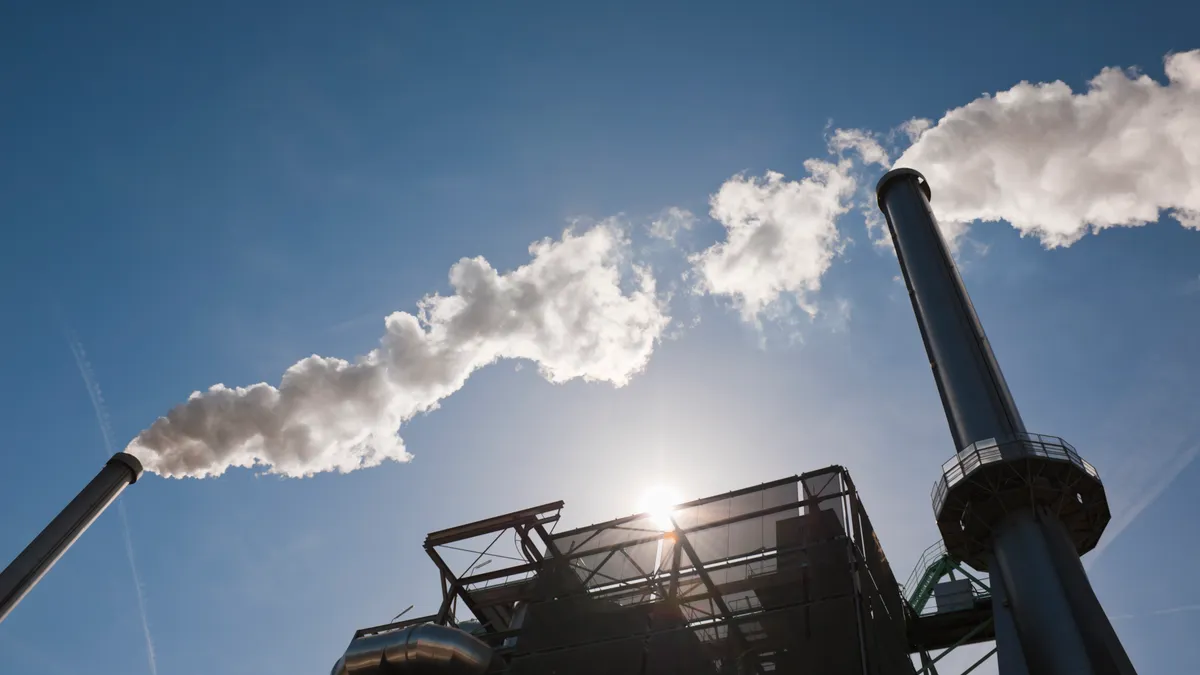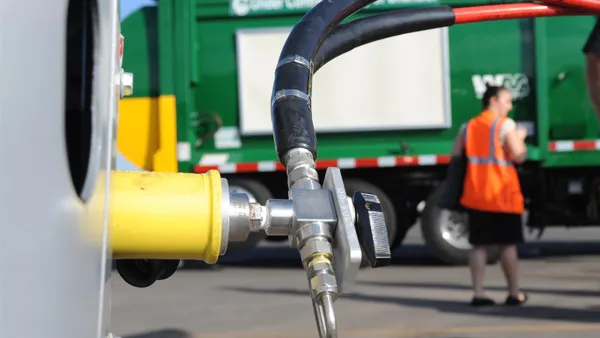As climate change mitigation goals increase scrutiny of the waste disposal industry, combustion facilities in Europe are testing how carbon capture programs might ease the pressure on their operations.
The choice to tack carbon capture use and sequestration systems (CCUS) onto incinerators, often referred to as waste-to-energy facilities, hasn’t gained noticeable traction in the U.S. But in Europe, where incinerators provide each nation with the ability to burn an estimated 170,000 metric tons of waste a year on average, progress is growing.
Companies such as Covanta, Suez and Veolia have recently built or announced plans to build systems on their European incinerators. The projects have few real-world examples to guide them, so estimates about key details like project financials, and how drastically the intervention could reduce greenhouse gas emissions, tend to have wide margins.
Meanwhile, other technologies already exist that could reduce emissions associated with waste disposal. These tools, like recycling and composting, can also help customers meet zero waste goals and play a role in decarbonizing the sector.
“We see that [carbon capture] has a role to play,” said Ann Ballinger, a principal consultant at U.K.-based consulting firm Eunomia. “But we also think that it's not the only game in town.”
Evolving landscape
European incinerators consumed about 27% of the region’s waste in 2020. The high-heat activities provide a small portion of power in various nations and, in some cases, repurpose steam to provide heating for nearby buildings. In Norway, the facilities provide about 3.5% of the nation’s energy and generate about 32% of all carbon emissions from its power sector. In Italy, the energy contribution hovers around 1% and makes up about 6% of all carbon dioxide emissions from energy production.
Policy and climate goals in Europe have promoted incinerators over landfills for decades — the 1999 landfill directive explicitly advocated moving away from burying waste and toward combusting it. Incinerators avoid methane, a powerful greenhouse gas that issues from landfills thanks to decomposing organic matter, and the power the facilities provided was considered cleaner compared with other options, like coal.
But as emerging sources of energy like wind and solar have changed, so has the European perspective on incineration.
In 2019, the European Union launched the European Green Deal, a program pledging to reduce emissions by 55% come 2030. The goal and legislation that followed are what Manon Roussel, the circular economy policy officer for the European Suppliers of Waste to Energy Technology (ESWET), considers to be an impetus for investments in CCUS.
To rein in global warming and reduce the net amount of carbon that industry adds to the atmosphere, nations around the world are pursuing emissions capture programs. The technology added to a facility, which can be custom-made or off-the-shelf, collects the carbon dioxide and methane leaving an industrial site. “There's still some policy gaps, but there is more visibility today to invest,” she said.
In July 2020, the revamped EU taxonomy set a definition for “environmentally sustainable” economic activities that excludes incinerators. The standards determine which projects are eligible for some EU funding and mean to guide private financial institutions toward climate-friendly investment choices.
If an incinerator operator wants to add CCUS to their facility, however, the EU recently opened a new funding opportunity for the construction. The Innovation Fund, meant to help decarbonize industry in the European Union, will award grants to proposals for systems that reduce or mitigate emissions, including CCUS systems on incinerators. Applicants fall into one of two categories — projects that will cost either above or below $9.4 million — and the fund will pay for up to 60% of the proposed installation.
Simultaneously, the EU wants to start certifying carbon removal systems. The agency put out a call for public feedback on what monitoring and proving a functional carbon capture system could look like. ESWET chose to weigh in on the behalf of incinerator operators who want to install the systems, said Roussel.
The CCUS projects consist of two halves: Capture followed by use or sequestration. Most facility operators will likely opt for what’s called post-combustion capture. Treated flue gas leaving the incinerator would go not into the open air, but into a contained solvent, which binds to and removes about 90% of the carbon dioxide. High temperatures re-separate the two to leave a pure CO2 gas. Pressure or low temperatures turn the CO2 into liquid, which flows through pipes or into the back of trucks to reach storage sites such as depleted oil or gas fields.
The U in CCUS stands for “use,” meaning some capture systems operators choose to sell the carbon rather than store it. One popular application is pumping the CO2 into oil and gas deposits to push more fossil fuels out of the reservoirs. Other uses might appeal to operators if their facility is too far from a storage site to justify the cost of piping the liquid underground, Roussel said, but it’s too early to assess broader trends.
Captured carbon could get funneled into construction materials, a destination Covanta chose for the carbon that’s supposed to be captured from two U.K. incinerators under construction. The facilities will merge residues with carbon dioxide to make manufactured limestone.
Critics say that building materials made from incinerator residue run a risk of leaching contaminants into their surroundings. When asked for its stance, ESWET passed along an unidentified member’s comment that said turning 100% incinerator residue into manufactured limestone "is not in line with our vision" and is only acceptable "if we can demonstrate a sink principle for the most harmful pollutant."
"Our position is that, as long as the synthetic limestone has a similar composition of natural limestone, we can accept these materials," they said.

Use cases
The only known working CCUS system on an incinerator in Europe sends its carbon to another possible destination — a greenhouse, to boost plant growth. Owned by waste company AVR, the facility in Duiven, Netherlands, started operating in October 2019. In 2023, another incinerator operator in the Netherlands plans to do something similar after a $15.3 million construction process wraps up.
As the Dutch project price tag suggests, carbon capture systems are expensive to install. The cost rises if the incinerator is older and needs retrofitting to accommodate the equipment, said Eunomia’s Ballinger. The power needed to collect and move the carbon dings power outputs from the facility, too. A case study for the International Energy Agency found that a CCUS system on a hypothetical incinerator, and the resulting steps for the captured carbon, would consume half the energy generated.
Even with these costs and losses, use cases for incinerators could be less expensive than similar technology added to other industrial sites. “But they're also not sucking up that much in the way of [carbon capture],” Ballinger said, as the sheer volume of emissions is lower than other facilities might emit. In a November 2020 report, Eunomia estimated that installing CCUS on incinerators would cost between $83 and $138 per metric ton of CO2 avoided, though other estimates put the price tag around $200. Industries like glass production, meanwhile, clock in at about $139-189 per ton of carbon, while cement manufacturing sits between $100 and $176.
The most cost-effective incinerator installations would likely be those that tap into carbon sequestration clusters, or patches of industrial facilities that share equipment. “This could still be quite high, but it's much more likely that they will get it off the ground since the pipeline is being built anyway,” Ballinger said.
A few waste companies have started exploring what these cluster partnerships would look like, with only a handful of existing facilities joining the hubs. Suez announced in 2020 that it will work with BP to test the feasibility of sending captured carbon from an incinerator to a storage location beneath the North Sea as part of the Net Zero Teesside CCUS cluster. An incinerator in Norway will participate in a different grouping of industrial sites called the Borg CO2 project that also plans to store liquefied carbon under the same body of water.
Incineration paired with CCUS either creates net-zero or net-negative carbon contributions to the atmosphere depending on the material, according to ESWET and industry consultants. The method of defining this net impact from waste derives from U.N. Intergovernmental Panel on Climate Change standards on incineration. Those standards discuss carbon emissions that are primarily carbon dioxide, as burnt-up materials don’t decompose and release methane like the waste would in landfills. The guidelines take the position that emitted carbon from burned paper, food and wood waste is net-neutral; while emissions from fossil fuel-based products add carbon into the atmosphere.
How CCUS changes these calculations is nuanced and open to some interpretation, as the results aren’t codified by government agencies or other third-parties. “I’m not aware of anything where this is laid out in a transparent way,” Ballinger said.
Plastics, composed of extracted oil and gas, have their carbon returned to the earth when burned and buried as part of a CCUS system, a turnaround often considered to be a net-neutral carbon consequence. Paper products get more complicated. If they comes from recently-harvested trees, an accounting system might mark incinerated and stored paper carbon as a net-negative, as the plants recently grew and stored atmospheric carbon that is now prevented from reentering the atmosphere. However, if the material being burned is from older growth that might represents decades of carbon that was sequestered in the wood, bringing incineration and storage to a net-neutral scenario, Ballinger said.
In some cases, calculations might also assume trees are planted to replace the ones removed for paper products. This accounting choice shows how quickly carbon tracking becomes a multi-industry problem, and one that doesn’t yet have robust third-party standards in place. For instance, a system that captured carbon from paper-pased emissions might be claimed as a net negative emission result for the waste company.
But if forests aren’t replanted, “you're not going to really be able to get to that true net negative outcome at the end of the day,” said Michael Walsh, an independent decarbonization strategist in the U.S.
What’s next
In June 2021, the Environmental Services Association (a trade association representing the U.K. waste industry) put out a plan to reach net-zero emissions that included, along with removing plastics from incinerator feedstock, a “roll out [of] carbon capture technology across our energy from waste facilities by 2040 where feasible.”
Some locations might be too old or expensive to retrofit with CCUS, or too far from offshore carbon storage options, said ESA press representative Ben Johnson. “Deploying CCUS is more complicated for in-land projects far from the clusters until more carbon usage markets become available,” he wrote via email. Though the association thinks individual facilities could have net-negative carbon outcomes, depending on what they burn.
The math assumes every incinerator receives the right ratios of materials to make the balancing work, something Johnson says the ESA expects to bend in the favor of net-neutrality if recycling goals in the U.K. are reached and a higher percentage of what goes to incinerators includes besides plastics.
Zero waste advocates have their own concerns about CCUS expansion on incinerators and the potential for a “lock-in effect.” Even if CCUS additions are funded by grants from the EU or other sources, communities or companies are left paying for the rest of the facility, possibly via loans.
Making back the investment or turning it into a profit means the facilities will need continued use — which may sustain demand for materials to burn at a time when governments are also trying to create less waste overall. With costly investments meant to mitigate the emissions from trash, “It would be very difficult for you to argue to minimize waste in the first place,” said Janek Vahk, the climate, energy, and air pollution program coordinator at Zero Waste Europe.
Vahk is particularly concerned about the possibility that some incinerators importing waste to meet contractual demands would receive CCUS funding from the EU. Already, incinerators in some parts of Europe need to import trash to meet production capacity demands, a situation that anti-incinerator groups say supports their argument that the region has over-built incinerator capacity. Government officials in nations that have had to import waste to burn have spoken out about how the practice runs against climate change goals, with health effects from emissions also sometimes raised as a concern.
Opponents argue that if operators were to tack CCUS onto these hungry incinerators then the technology would further entrench its role. “[If you build that] you have to bring more and more waste to incinerate instead of trying to minimize waste incineration,” Vahk said. “That's exactly the kind of situation that we want to avoid.”
Ultimately, Ballinger said, broadly-applied CCUS on incinerators could potentially weaken the incentives for shifting to a more circular economy. Products that could be recycled or reused may have their carbon stored away, but the items still end up incinerated and leave gaps in the supply chain for product manufacturers to fill with virgin materials.
Storing emissions lessens pressure upstream to reduce production, adds Walsh. “You have these plastic emissions that are being captured, and yes, you don't want those to go back in the atmosphere. Ideally, you would have recycled some of that plastic or not even produced it from the get-go.”
Weighing the cost per pound of carbon emission avoided would also show recycling to be a cheaper option than CCUS in a vast majority of applications, Ballinger said, even though the potential costs of CCUS are still in flux. The technology to pull materials from curbside collections already exists and operates at high-performance sorting plants, whereas a lot of the CCUS equipment is still in trial phases. At the same time, the most profitable and the most sustainable outcomes may not always be one in the same.
“If you're an incinerator operator, you don't necessarily want too much material going elsewhere and being tackled outside of your control,” Ballinger said. But there are recyclable extraction systems that can be paired with incinerators themselves, she adds.
Growing pressures around alternative energy sources and decarbonization goals have prompted debate in the incinerator industry about whether there will always be as much capacity in Europe as there is today, said Roussel. Though whatever is left for disposal in a future with maximum reuse may still be enough for the industry to work with.
Patrick Clerens, secretary general with ESWET, said that even if materials are recycled as many times as they’re designed to, some of the products like plastics and paper still end up needing a final disposla option. When that time comes, incinerators will be able to step in and they will still have emissions.
“We really push for recycle, recycle, recycle whatever you can, reuse and recycle,” he said. “We will take the residual and it's fine. There's more than enough residual waste.”










